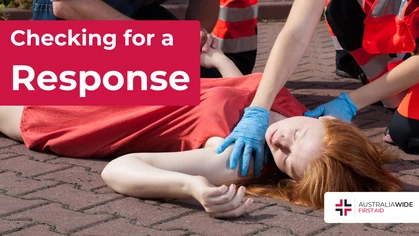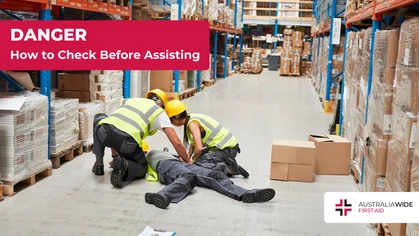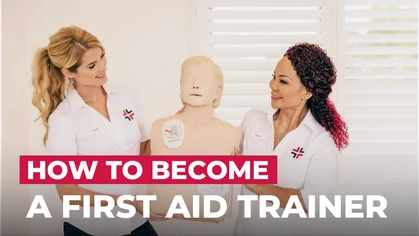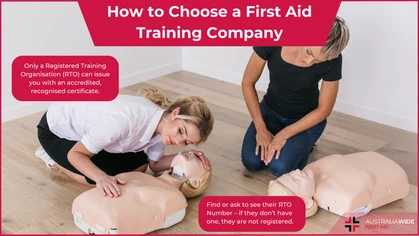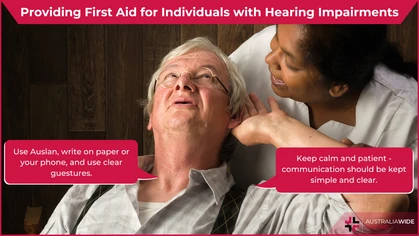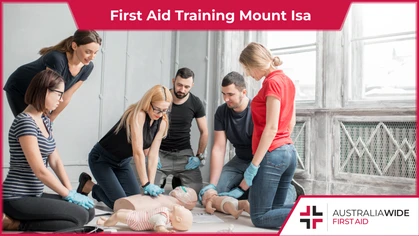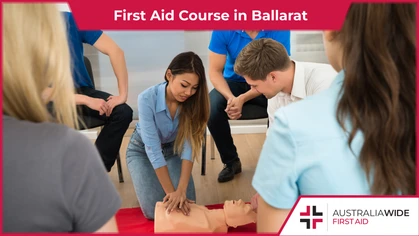First Aid Course Parramatta

First Aid Training
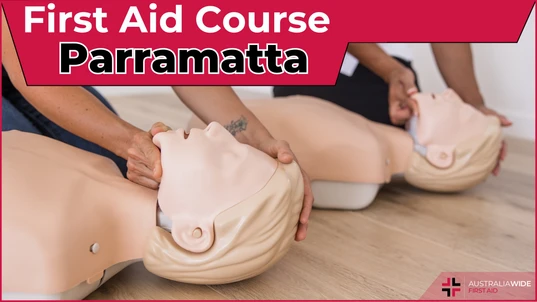
Our first aid course Parramatta is innovative, inexpensive, and nationally accredited. Upon completing our first aid course Parramatta, you will have the knowledge and skills to manage a variety of medical emergencies.
Just a 30-minute car ride away from the Sydney CBD, Parramatta is a major business and commercial centre. Parramatta is well-known for housing Westfield Parramatta, the tenth largest shopping centre in Australia. But did you know that it is also home to our first aid course Parramatta? Our first aid course Parramatta is cheap, convenient, and nationally accredited. Likewise, it will empower you with the knowledge and skills to prevent and manage a variety of first aid emergencies. In this article, we will look at why completing our first aid course, including our first aid course Parramatta, is one of the best ways to look after your wellbeing and the wellbeing of those around you. Click here to Enrol Now in our first aid course Parramatta, the formal name for which is HLTAID011 Provide first aid.What is first aid, and why is it important?
First aid is the immediate medical assistance rendered to a person who has sustained a sudden illness or injury while waiting for professional medical care. First aid treatment is not a substitute for professional medical care. However, having a competent first aider on hand during a medical emergency can make the difference between life and death. Competent first aiders are trained to take control of the emergency scene and respond confidently to the casualty's condition. This subsequently reduces the casualty's risk of death or permanent disability. Likewise, competent first aiders are taught to identify and minimise potential hazards in the home and workplace, which is why first aid training is a requirement for many Australian jobs.What are the 'Three Ps' of first aid?
The importance of first aid is captured by its three objectives - the 'Three Ps':- Preserve Life: The primary objective of first aid is to preserve live. This means following the DRSABCD action plan to assess the emergency scene for danger, to call Triple Zero (000) or 112 for an ambulance, to check the casualty's breathing, and to commence CPR and defibrillation as necessary. DRSABCD is designed to keep the casualty and others at the emergency scene safe until an ambulance arrives. We will break down the steps of DRSABCD in the next section.
- Prevent Deterioration: The second objective of first aid is to prevent the casualty's medical condition from deteriorating while waiting for an ambulance. This involves helping the casualty into a safe and comfortable position, and using first aid principles to treat their condition/s, whether that be a burn, fracture, or seizure.
- Promote Recovery: The third objective of first aid is to encourage the casualty's confidence and relieve their pain. This objective can go a long way in aiding the casualty's recovery process.

DRSABCD is the essential action plan for first aid situations. It helps first aiders prioritise their actions and keep the casualty and bystanders safe until formal medical intervention arrives.
What is DRSABCD?
As we mentioned earlier, the primary objective of first aid, to preserve life, hinges on the use of the DRSABCD acronym. DRSABCD is the essential action plan for first aid situations. It outlines the sequence of steps a first aider should take when they encounter an ill or injured person. The purpose of DRSABCD is to maintain the casualty's safety, and the safety of others at the emergency scene, while waiting for an ambulance:D for Danger:
When you come across a medical emergency, firstly assess the scene for any physical threats to yourself, the casualty, or other bystanders. Examples of danger could include live wires, moving vehicles, or the casualty themselves. If you do not assess the scene for danger, you could run the risk of adding more people to the casualty count, which would make first aid unmanageable.R for Response:
Once you have assessed the scene for danger, use the COWS acronym to assess whether the casualty is responsive:- C: Can you hear me?
- O: Open your eyes.
- W: What is your name?
- S: Squeeze my hands.
S for Send for Help:
First aid is not a substitute for professional medical care. As such, once you have assessed the casualty’s responsiveness, shout for someone in your vicinity to call Triple Zero (000) or 112 for an ambulance. You should also get another person to fetch a defibrillator. If no one is around, contact emergency services yourself.A for Airway:
Lift the casualty's chin and tilt their head back to check that their airway is clear. If their airway is obstructed by foodstuffs, dentures, or any other foreign item, roll them into the recovery position and sweep the debris out with your fingers.B for Breathing:
Assess whether the casualty is breathing normally by seeing if their chest if rising and falling, by listening at their mouth for sounds of normal breathing, and by placing your cheek near their mouth and feeling for air. If the casualty is breathing normally, roll them into the recovery position, and monitor and treat their condition until the ambulance arrives. If the casualty is not breathing normally, move onto the next letter of the DRSABCD acronym.C for Cardiopulmonary Resuscitation (CPR):
CPR is the essential first procedure for treating a casualty whose heart has stopped beating. CPR imitates the function of the heart and lungs. It keeps oxygenated blood flowing around the body until professional medical care can be used to restart the heart. Head to our Chart Library for step by step instructions on how to perform effective CPR on adults, children, and infants.D for Defibrillation
If the casualty does not resume breathing or consciousness after administering CPR, use an automated external defibrillator (AED) to restart their heart as necessary. AEDs are portable, compact machines that can deliver an electrical shock to return the heart to its normal rhythms, when appropriate. AEDs come with inbuilt verbal instructions, so simply follow the prompts until an ambulance arrives. Head to our Resource Library for more information on how to apply AED electrode pads to a casualty’s body. As you can see, DRSABCD is primarily focused on how to help an unconscious person who is in need of CPR or defibrillation. DRSABCD does not cover other first aid principles, such as how to treat the symptoms of asthma, strokes, or heart attacks. These first aid principles are addressed in the second objective of first aid, to prevent deterioration.First aid course Parramatta
In our first aid course Parramatta, which is formally known as HLTAID011 Provide First Aid, you will learn how to respond to medical emergencies using DRSABCD, how to perform CPR, how to use an AED, and how to apply first aid principles for a variety of injuries or illnesses, including shock, hypoglycaemia, and hypothermia. Trained in accordance with the Australian Resuscitation Council (ARC) guidelines, our first aid course Parramatta comprises an online eLearning component and face to face assessed training. The online eLearning component is a multiple-choice quiz that you can attempt as many times as you need with the support of our free First Aid eBook. It is recommended that you allow up to 6 hours to complete the online eLearning component, which must be completed at least the night before attending your first aid course Parramatta. Once you have completed the online eLearning component, you will get to test your knowledge during the face to face assessed training with the support of an experienced AWFA trainer. This component takes 4 hours in a classroom environment. We pride ourselves on developing the most effective first aiders possible, which is why the trainers at our first aid course Parramatta are industry leaders who have a wealth of personal and professional experience in first aid situations. Our first aid course Parramatta also has the following amenities to keep our students comfortable and engaged in the learning process:- Parking only walking distance away.
- Accessible via public transport, including the Parramatta train.
- Toilets.
- Drinking water.
- Classroom-style seating.
- Hygiene in line with current infection controls.
- HLTAID009 Provide cardiopulmonary resuscitation(CPR): Learn how to respond to an emergency using DRSABCD, how to perform CPR, and how to use an AED.
- HLTAID012 Provide first aid in an education and care setting: Learn how to respond to an emergency using DRSABCD, how to perform CPR, how to use an AED, and how to provide first aid in emergency situations common to the education and care industry, such as anaphylaxis and asthma.
How often should I complete first aid training?
Fortunately, emergency situations are few and far between, and first aiders may go years without implementing their first aid knowledge and skills. And time is of the essence in emergency situations. So even though first aid certificates do not expiry, Safe Work Australia recommends refreshing them as follows:- HLTAID009 Provide cardiopulmonary resuscitation: 1 year from the date of course completion.
- HLTAID011 Provide first aid: 3 years from the date of course completion.
- HLTAID012 Provide first aid in an education and care setting: 3 years from the date of course completion.
Final thoughts
Our first aid course Parramatta is one of the most convenient and inexpensive ways to contribute to the safety of your local community. In our first aid course Parramatta, you will develop the knowledge and skills to respond confidently to a variety of emergency situations, including how to use DRSABCD to assess emergency situations, how to perform CPR, how to use an AED, and how to apply first aid principles to different injuries and illnesses. You will also develop the ability to identify and minimise potential hazards and subpar emergency responses in the home and workplace. As such, following the conclusion of your first aid course Parramatta, you will be instilled with a holistic understanding of how to preserve life, prevent deterioration, and promote recovery during emergency situations. AWFA is a registered training organisation, so our first aid certificates are nationally accredited and recognised. Ready to enrol in our first aid course Parramatta? No worries – head to our Locations page and follow the prompts!
Originally published at
https://www.australiawidefirstaid.com.au/resources/first-aid-course-parramatta
as part of the Australia Wide First Aid Articles Library
